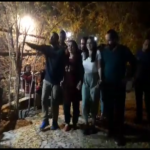
Si chiama Kanlaon, è alto 2435 metri, ha un diametro di 30 chilometri e si trova nelle Filippine centrali. E’ un vulcano attivo, che ha eruttato l’ultima volte nel 2006, ma ha fatto sentire la sua voce potente ben 26 volte nell’ultimo secolo.
Mt. Kanlaon or (Kanla-on or Canlaon), is an active volcano located in Canlaon City, Negros Occidental in Central Visayas Region, Philippines.

Mt. Kanlaon has erupted 26 times since 1919. Eruptions are typically phreatic explosions of small-to-moderate size that produce minor ash falls near the volcano. In 1902, the eruption was classified as strombolian, typified by the ejection of incandescent cinder, lapilli and lava bombs.

Mt. Kanlaon has a peak elevation of 2,435 m (7,989 feet) with a base diameter of 30 km (19 mi) and is dotted with pyroclastic cones and craters. Just below and north of the summit is the active Lugud crater. North of Lugud is a 2 by 0.8 km (1.2 by 0.50 mi) caldera, known as Margaja Valley, with a crater lake.

The volcano has three hot springs on its slopes: Mambucal Hot Springs on the northwest, Bucalan Hot Spring, Bungol Hot Spring.
The volcano is a favorite spot for mountain climbing and is the centerpiece of Mt. Kanlaon Natural Park, a national park originally established on August 8, 1934. It is also one of the most active volcanoes in the Philippines, which contributes to the danger involved, as well as the naturally lush environment and rich, bountiful soil around the mountain. Needless to say, only experienced mountaineers who are willing to take the risk should attempt this challenging adventure, but it’s well worth it by overcoming the challenge and seeing the amazing sighs of Mt. Kanlaon.

More than 40 kilometers of foot trails at the Mt. Kanlaon National Park leads to the summit, the shortest of which is the eight-kilometer Masulog trail. The Ara-al and Mapot trails could take up to a day while the longest route takes trekkers deep into the wilderness for two days before reaching the summit. A climbing permit from DENR is required to climb, and the number of climbers is limited to 10 persons.

Mountaineering is open during the months of March to May and October to December. The months of January, February, June, July, August, and September are low season wherein only one expedition party per trail per month is allowed. However, the park is closed to mountaineering during bad weather or when PHIVOLCS declares that there’s a volcanic activity.

It’s More Fun in the Philippines.




